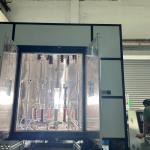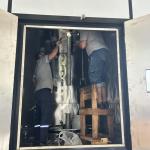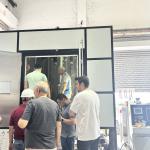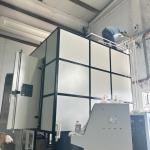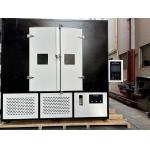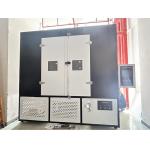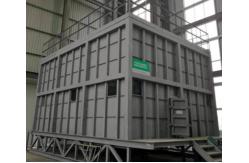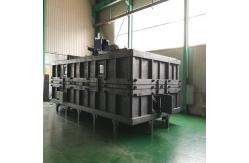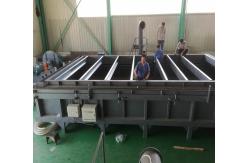DX8785 Roofing system wind resistance testing machine, roof wind resistance
testing equipment
【Test items】Static roof wind resistance test, dynamic roof wind
resistance test, metal roof wind resistance lifting test, metal
roof physical properties.
【Applicable Standards】
GB/T 31543 "Test Method for Wind Resistance of Single-layer
Membrane Roof System", JGJ 255 "Technical Specification for
Lighting Roof and Metal Roof", GB50896 "Technical Specification for
the Application of Profiled Metal Sheet Engineering", GB 12952 "PVC
Waterproofing Membrane", FM 4471 "Certification Standard for Class
I Plate Roofing", ANSI FM 4474 "Wind Resistance Test for Simulated
Roof System by Positive/Negative Pressure Method", ETAG006:
European Technical Certification Guidelines for Mechanically
Fastened Flexible Roof Waterproofing Membrane Systems>
【Technical Parameters】
● Wind pressure control range: -10000Pa~10000Pa, accuracy: 0.5%
● Air flow test range: 0~360m³/h, accuracy: 2.5%
● Water flow test range: 0~6500L/h (optional), accuracy: grade2.5
● Displacement test range: 0~80mm, accuracy: grade 0.1
● Pressure pulse process time control deviation: boost: 0.7~1.0s,
continuous: 2~3s, buck: ≥4s
● Number of cycles: can be set arbitrarily, and the accuracy of
frequency control is 100%
● Maximum specimen size: 7300×3700mm
● The design value of the maximum negative wind load can be set
arbitrarily, and the default method of the pressurization process
is the standard method, and the expansive requirements of the
pressurization process program can also be artificially customized.
● Power supply requirements: AC 380V, 65kW
● Floor space: length×width× height=10500×6500×4800mm
Metal roof wind pressure resistance testing machine
Standards:
GB/T 15227-2007
GB/T 34555-2017
Guangdong Provincial Standard DBJ/T 15-148-2018 "Technical
Regulations for Metal Roofing in Areas Prone to Strong Winds"
Canadian Standard A123.21-04 "Standard test method for the dynamic
wind uplift resistance of mechanically attached membrane_roofing
systems"
Australian Standard AS 4040.3-2018 "Methods of testing sheet roof
and wall cladding Method 3: Resistance to wind pressures for
cyclone regions"
Test methods for thin roof and wall cladding Part 3: Resistance to
wind pressure in hurricane areas
Rationale:
Two static pressure boxes are adopted, and the metal roof is
sandwiched in the middle; By connecting with the independent
pressure generation air source and the pipeline system and the
waterway system, the main function is to complete the performance
test of the air tightness and water tightness of the building metal
roof, as well as the static wind load and dynamic wind load
performance, and complete the real-time wind pressure monitoring of
each layer inside the metal roof structure.
Key features:
Adopt and integrate contemporary advanced industrial computer
distributed control technology (DCS), fan AC frequency conversion
speed regulation technology, intelligent instrument communication
technology, intelligent valve drive technology, computer automatic
control technology, graphics technology, real-time database
technology;
The computer monitoring software system has dynamic and realistic
graphic display, smooth and accurate process control, rich data
query and printing, and friendly man-machine dialogue;
It has the characteristics of accurate data, automatic control,
simple operation, stability and reliability, and long mean time
between failures;
Wind pressure measurement range:
Maximum wind pressure range (static/dynamic): -15000Pa~15000Pa;
Air tightness test wind pressure measurement range: -1000Pa~1000Pa;
Pressure accuracy class: class 0.5 ;
Displacement test range: 0~50/0~100;
Displacement test accuracy: ±0.1mm;
Control Indicators:
1) Wind pressure resistance detection:
A. Deformation detection: ±1.5% of the target value of pressure
control;
B. Preparatory pressurization and repeated pressurization
detection: ±1.5% of the target value of pressure control;
C. Grading and engineering testing: ±2% of the target value of
pressure control;
2) Fluctuating wind pressure detection: ±2% of the target value of
pressure control;
Monitoring software: Through intelligent operation software, the
changes of each load data in the laboratory can be displayed and
processed intuitively, efficiently and conveniently. The actual
deformation value of each stage of static load when the pressure is
saturated, and click on 2 to observe the residual change value when
the pressure of each stage is zeroed.
2. The static pressure box is connected with the pipeline
The static pressure box is composed of two upper and lower boxes,
the lower box is a sealed box, which is fixedly installed on the
ground, and the specimen frame is placed on the lower casing for
the installation of the specimen; The upper box is open, lifted and
removed with a crane, and the lower box is connected with the air
pipeline, and the upper box can be connected with the fixed air
pressure pipeline with a detachable steel pipe;
3. System control principle
It adopts industrial computer, PLC programmable controller, and
intelligent instrument two-level computer distributed monitoring
system, which has the function of automatic control of the
detection process, automatic collection of detection data,
generation and printing of detection reports, and historical data
query.
4. Air pressure signal acquisition
Six pressure transmitters of different capacities are used, namely:
1. Measure the pressure of the upper static pressure box, 2
pressure transmitters;
2. Measure the pressure of the lower static pressure box, 1
pressure transmitter;
3. Measure the pressure between the outer surface and the inner
layer of the specimen, 2 pressure transmitters;
4. Measurement of airtight pressure: 1 pressure transmitter;
Ensure the accuracy of the pressure data and the response speed of
the transmitter under high and low pressure, so as to ensure the
accuracy of the wind pressure experimental data.
5. Acquisition of deformation and displacement signals
Fifteen displacement sensors are used, and 24-bit data acquisition
equipment is reserved, including:
1) 10 pieces of 0~50mm range;
2) 5 pieces of 0~100mm range;
The accuracy and stability of the displacement measurement can be
guaranteed in a sufficiently large deformation range, so as to
ensure the accuracy of the wind pressure deformation test data.
6. Wind source and wind pressure generation and adjustment
Independent high-speed centrifugal fan is adopted, and the
high-power centrifugal fan is connected to the upper static
pressure box to provide uniform wind pressure under large permeable
air flow, and the outlet static pressure is not less than ±15000Pa;
The minimum resolution of adjusting the wind pressure is 10Pa, and
the minimum resolution of the wind pressure is 10Pa, and the
equipment has no impact on the power grid when it is started, with
low noise and low vibration, and can save energy by 30~50%. The
valve actuator in the device adopts electric servo control
technology, the system performance is stable, high-speed, and the
control accuracy is high, which fully meets the technical
requirements of the testing equipment.
7. Positive and negative pressure reversing system
The equipment adopts a unique positive and negative pressure
reversing device, which is flexible and reliable, and realizes the
positive and negative pressure conversion of wind pressure.
8. Air-tight and watertight detection system
This equipment has an airtight and watertight detection system,
equipped with a water pump, a water flow meter, a water pipeline
and a nozzle; The anemometer and the corresponding measuring line
can test the air tightness and water tightness of metal roofs.
Note: The above configuration is for reference only, if there is
any change in the model, the actual site situation shall prevail.
Curtain wall four performance test:
1. Wind pressure deformation performance, air infiltration
performance, rainwater infiltration performance and plane content
deformation performance;
2. Wind pressure resistance test of glass curtain wall: refers to
the ability of the curtain wall to maintain normal use function and
no damage under the action of wind load perpendicular to it.
3. Glass curtain wall air tightness performance test: refers to the
performance of preventing air from passing through the curtain wall
when the open part is closed under the action of wind pressure;
4. Watertightness performance testing of glass curtain wall:
watertightness is related to the use function and life of the
curtain wall, and is related to the importance of the building, the
use function and the climatic conditions of the location, and the
average wind pressure of 10 minutes is used as the basis for
grading;
5. Detection of the deformation performance of the plane content of
the glass curtain wall: it is due to the follow-up deformation
caused by the relative displacement of the various floors of the
building after the building is subjected to wind load or
earthquake;
